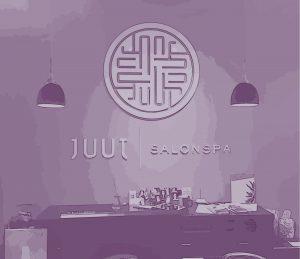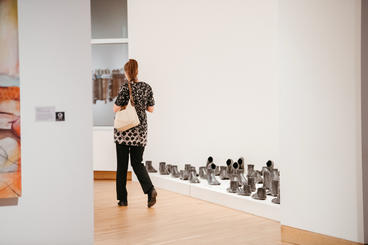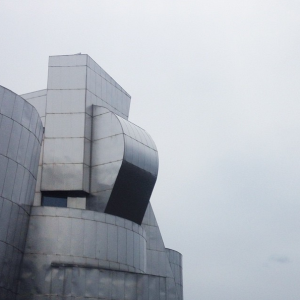We’re a week away from WAM Collective’s fourth annual design event: Eye Candy. This year, we will be hosting a showcase of outfits created by apparel design students from the College of Design. The garments this year are inspired by Feast: Radical Hospitality in Contemporary Art, the featured exhibition at the Museum. If you haven’t seen the exhibition yet, go see it! The collection contains pieces that explore different meanings and values that are found in the act of sharing a meal. We’ve had a series of great participatory events related to the exhibition since its opening back in February, including our upcoming Pop-Up Park-The Sweet Spot- that will be opening only two days before the showcase on April 20th! Much fun to look forward to! So. Food and fashion. It seems to be a pretty intriguing topic to be undertaken by this year’s apparel students! But, we decided to ask them ourselves.
Julia Adamson.
Why did you decide to become an apparel design major? Why are you/when did you become interested in designing clothing? What are your aspirations? The first time I told my parents I was going to design clothing for a living I was seven years old. Over the years my career aspirations changed, frequently. In the end it took a staring contest with a blank college application for me to realize that in eleven years the only career I had seriously considered more than once was apparel design. That, coupled with the fact that designing clothing had become a favorite past time somewhere along the way led to me applying for the Apparel Design Program here at the U. With the knowledge and experience I gain from this program I hope to design for a well known label that focuses mainly on high fashion as I love to work with luxury fabrics and structured designs.
What part of Feast most interests you? How is that reflected in your design? The concept of Feast I found most interesting was the role of host and guest. My design showcases how preparing to interact with dinner party attendees is akin to preparing for battle.
Megan Clarke.
What is your work usually like? My work tends to be inspired by historical costume and fantasy elements due to my fascination with costumes used in film and theatre. I enjoy creating contrast through color blocking, changing up style lines, and incorporating very structural elements with loose, unifitted details.
Does it make sense/is it comfortable for you to draw inspiration from an art exhibition? I believe that art exhibitions are a fantastic source of inspiration. For this project especially, being able to draw inspiration from the themes presented in the existing artwork really helped narrow down and focus the design process while still leaving room for my own interpretation.
Melissa Feidt.
What materials did you use and why? Were there any particular challenges using them? I used materials that I work with at my other job as a bartender - beverage straws and coffee filters. I chose to use these since I take on the role of host every time I work. It is my job to ensure my guests, many of whom I don't know, are having a good time. The straws were definitely a challenge to manipulate. When you're working with thousands of straws strung onto fishing line, they tend to be very difficult to control and isolate.
What is your work usually like? My work is very feminine. I love being a woman and everything that goes along with it. I celebrate the female form and that is definitely reflected in my aesthetic.
Sophia Gillian.
How does apparel design play into your other interests, workplace, home life, etc? I work at Parc Boutique in Northeast Minneapolis and Thao, the owner, has made the store into something that has been a large aspect of my inspiration. We carry some smaller brands by designers who are able to design and make their clothing here in the U.S. so it is nice to be surrounded by larger brands as well as these smaller, more personal brands as something to aspire to.
What materials did you use and why? Were there any particular challenges using them? I used oilcloth, the material used in Mexican tablecloths, hot peppers, beans, corn husks and a few other Mexican inspired materials. I wanted to create a traditional Mexican dress that looks like it was embroidered with beads when they were actually dried foods. I didn't have many challenges once I figured out the correct types of glue and thread to use.
Mikaela Harrod.
What is your work usually like? My style ranges from loose and draped; basically hippie style, to Euro-chic style. However definitely not as colorful and loud as this piece, although it was fun and challenging to go out of my comfort zone and create a very stand out design.
What meal traditions do you have? My family doesn’t have many meal traditions we follow, but the one that is pretty different is that we have spaghetti and meatballs on Christmas night, we are German not Italian. So that’s the one that’s a little strange, but I love it.
Sinead Kelly.
What part of Feast most interests you? How is that reflected in your design? I loved working with the unconventional items to represent a story about hospitality. My friend recently pointed out that my designs always have some kind of story behind them. I suppose that is what I like about Feast, it allows me to utilize my kind of inspiration in a new and unconventional way.
What materials did you use and why? Were there any particular challenges using them? My look takes inspiration from the Japanese tea ceremony of Japan that is all about respect, patience, care, etc. I used steeped tea bags, wire and LED lights to create a modern Japanese lantern as a skirt. I made a corset out of broadcloth that is covered in cocktail umbrella's to represent the colorful garments, prints and designs found on Japanese kimono's and the parasol's that Geisha would carry. Finally, I used the symbolic folding fan as a hair accessory. It was definitely most challenging figuring out how to make the very fragile cocktail umbrella's work out with the corset.
Sarah Klecker.
How does apparel design play into your other interests, workplace, home life, etc? I want to design performance apparel because I myself am an athlete. I run on the University's Women’s Cross Country and Track teams. Both my parents were world class runners in their prime and I am one of 6 children all of whom are athletes. Being surrounded by sport my entire life gave rise to an interest in apparel that could enhance the experience of sport and in innovation that could help athletes push the limits of the human body.
What meal traditions do you have? I come from a large family, so even though as all my siblings leave for college it becomes rarer, I treasure memories of shared family meals. We all gather around our huge kitchen table and sing the johnny appleseed prayer together before we eat. I am very close with my family and I believe that our tradition of eating with one another is a big part of that. Another favorite memory is getting up and eating breakfast with my dad before I'd go to school. He would be drinking his coffee and reading the paper while I ate my oatmeal and read the comics section of the paper (still the only section I read). When I come home from school he still sets aside the comics for me in the morning. Sometimes he even goes through and highlights the best ones. Lastly, me and my sister have a tradition of when I come home we make risotto together. It's one of our favorite recipes and as we stir the rice it gives us time to talk and catch up. We tweak the recipe to match seasonal vegetables and have also found that it tastes better if you double the amount of wine in the recipe! After dinner we make fruit crisp together. Mary (my sister) loves to host people for dinner and is amazing at finding recipes that I can eat (she's once went through the painstaking process of making me a gluten free/vegan birthday cake!). She is pretty much the definition of the perfect hostess. When I come to stay with her there is always clean sheets on the beds and fresh flowers in the guest room.
Sarah Mirman.
What part of Feast most interests you? How is that reflected in your design? The part of Feast that interests me the most is the freedom of expression that comes with it. Being able to design something based on a loose concept is liberating, especially when the concept can go several different ways. With food and hospitality being the main themes in Feast, I went in a different direction with my design—instead of celebrating food and the concept of eating, I brought attention to the opposite spectrum, those who struggle with eating disorders and body image.
What is your favorite place to eat in the Twin Cities/on campus? My current favorite restaurant is Shamrocks, purely because their hamburgers are on point.
Sydney Moustakis.
Why did you decide to become an apparel design major? Why are you/when did you become interested in designing clothing? What are your aspirations? Ever since I was little I was interested in apparel design. I used to put on my mother’s heels and walk around the house in her clothes. Although I don’t know exactly what position I want to secure in my future, I know that I love what I am doing and would be thrilled to get the opportunity to work for a company where I get to utilize my skills and design apparel that creates positive change in the field.
What meal traditions do you have? My favorite place to eat on campus is Annie’s Parlor, who doesn’t like a good burger and milkshake after a huge exam, or in my case spending countless hours in the studio.
Marina Qualey.
How does apparel design play into your other interests, workplace, home life, etc? After being in school and learning so much about the industry and softlines in general, it's difficult for it not to consume your life. I'm a manager at a clothing store, and I love being able to look at a garment and explain to a client the reasoning behind specific apparel assembly and the use of different textiles. It makes me confident in my daily life, and proud to call myself a design major.
Who would wear your look? Any very confident woman willing to wear a cocktail dress made out of paper (weather permitting).
Aaronn Richter.
Does it make sense/is it comfortable for you to draw inspiration from an art exhibition? Yes, very much so. I studied more of the fine arts in high school. My wife studied, briefly, at MCAD. We love going to art exhibits. So, finding inspiration there was not difficult. The only hard part about it was this feeling that I wasn't technically ready or capable for something that was actually going to be presented in an art museum. As an artist, being shown in an art museum feels like a really big deal, and I think a part of me feels a little inadequate.
What part of Feast most interests you? How is that reflected in your design? I am a big fan of Marina Abramovic. Her exhibit in Feast is looking back at an old piece she did on how two different worlds, that should hate each other, produced two lovers. And she represented their two worlds by the food that they eat. That exhibit interests me the most. However, I think what is more reflected in my design is the heart of Marina Abramovic. The thought that there is a main point to what you want to say, and you say it, but there are also all of these little underlying elements. That if you take the time to notice them, you will realize that you are being confronted about so much more. For example, the majority of my piece is made of aluminum foil. The main thing being said here is that this person has come from, and belongs in the kitchen. But aluminum foil is also reflective, which ties in almost every artists desire for the observer to take a moment of self reflection. Plus, I took more of a 'feminist' approach to me piece, and I think Marina embodies that movement in her work, and her life as well.
Leeah Schuhwerck.
What part of Feast most interests you? How is that reflected in your design? When it comes to the Feast exhibit, there are a lot of ways in which one can share a meal. However, no matter the event, culture, or food, they all seem to be centered on the idea of spending time with one another. This was the common factor between all the meals and the direction I went with my design.
What meal traditions do you have? My family regularly gets together for sit down dinners. It doesn’t matter what we are eating, the important thing is that we are spending time with one another.
Abby Schumacher.
What materials did you use and why? Were there any particular challenges using them? I draw inspiration from everything around me. It could be anything from a sculpture to how the light reflects off the wall. It was interesting to look at the Feast exhibits and projects and find inspiration in that. I think the dinner party aspect and comparing host vs. guest was the part that most interested me. For my design I chose to more closely examine the roll of host. I made my garment out of things that a host would use at a dinner party. I used broken cups and plates, doilies, and table cloths. The cups were very challenging to work with but by breaking them and using the doilies as a sort of 'grout' made them easier to maneuver and form over the body.
Who would wear your look? My design is intended to be worn by the hostess as a hostess dress. The high neckline represents how hosting guests can be nerve-racking and can feel suffocating at times but the bottom skirt is fun and flowy to represent how hosting can also be exciting and a good time. It was fun to try something new and step out of my comfort zone and I think by doing that I came up with something very unique.
Madelyn Topp.
Why did you decide to become an apparel design major? Why are you/when did you become interested in designing clothing? What are your aspirations? I decided to become an apparel design major because I have always been inspired by fashion and how it can display individuality and boost self-confidence. Creativity has always been one of my strong suits and I decided to channel it into apparel design. I became interested in designing clothing when I was entering my early teen years and I found myself thinking of garments and designs I wanted to wear but not knowing how to execute them.
What part of Feast most interests you? How is that reflected in your design? I was most interested in the role of the guest in a feast/hospitality situation and how the expectation of the guest is often unclear with can cause feelings of insecurity therefore the guest can use their clothes as a shield for their uneasiness. This was reflected in my design by making an elegant looking dress and using screws as a surface treatment so from a distance the dress sparkles with elegance but upon closer inspection it is rough around the edges and the screws are tarnished.
Kina Vang.
What is your work usually like? I say that my work is usually crazy and it's all over the place. I like trying new things so my works are not really consistent in a sense, but one thing for sure is that I like colors and I like to design something daring, yet wearable. I like to bring in inspiration from weird things, such as butterfly wings, flowers and such into my garments as they make good ideations and inspiration. Inspiration from anything can be turned into a design within my works.
What materials did you use and why? Were there any particular challenges using them? -I used watercolor paper to represent rice, as it's the main food served in almost every Asian culture. It doesn't make sense to others, but to me there is a meaning to all the materials used. Watercolor represents rice paddies, which is floating in water, therefore I chose watercolor paper. The material was super difficult to work with. It was not as flexible as I thought it would be and it was difficult to keep in one structure.
Advanced tickets are required. Reserve your ticket now.
Doors at 6:00 pm
Runway at 7:00 pm
Hair and Make-up provided by Juut Salonspa



